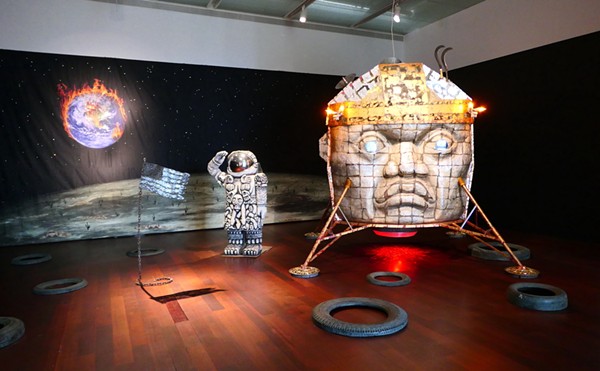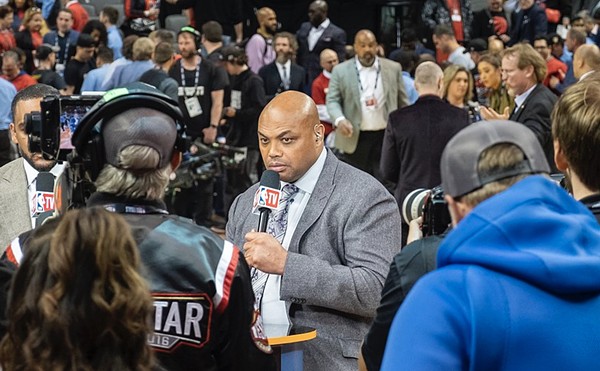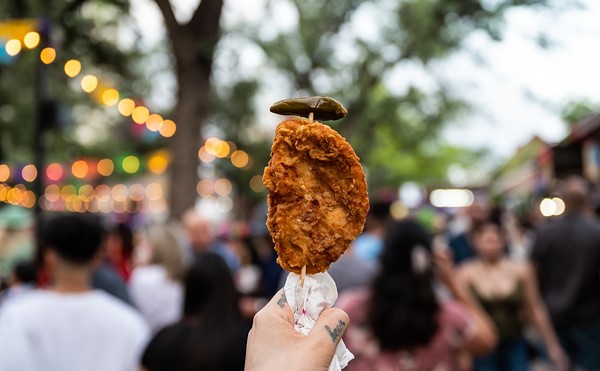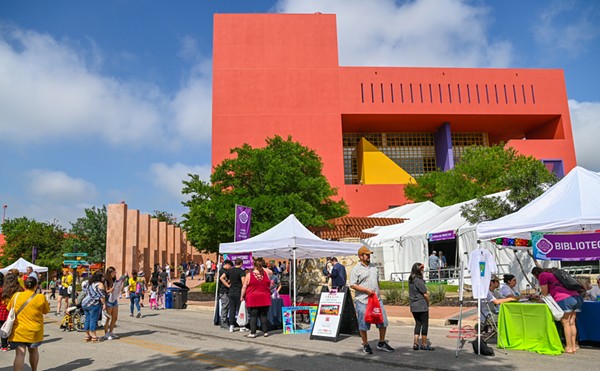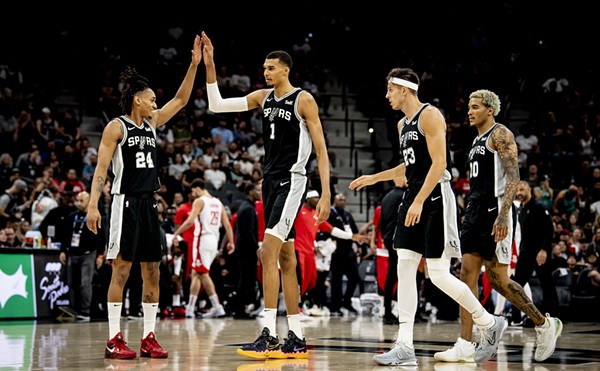Virginia Grise — native San Antonian, recent CalArts MFA grad, this year’s winner of the Yale University Drama Series with her original play Blu, and 2010 Luminaria artist — doesn’t have access to the Alamo. Not the building, anyway, that brick-and-mortar relic, at once stately and squat, that presides over the Ripley’s Believe It or Not and Pat O’Brien’s, and vouchsafes San Antonio’s role as a historically significant battlefield. Whether you see the former mission as hallowed locus for the martyrdom of Crockett, Bowie, Travis, et al (the Daughters of the Republic of Texas sure do), or as something more complex in its tragedy and significance — Luminaria-scale art pieces, whether structure- or performance-based, aren’t welcome at the Alamo. Not any more.
Reasons given vary. Some say that Laura Varela and Vaago Wieland’s “Enlight Tent” installation on the Alamo grounds last year — with its beautifully lit tipis evoking the human migratory patterns of millennia, and its photographic projections of faces of color and words like “home” and “mother” onto the Alamo’s stony face — unnerved a starchy Old Guard. Others maintain that set-up and break-down difficulties cost the City manpower, electricity, and equipment, and that the location impeded the flow of foot traffic.
So Grise and her Luminaria collaborators have set up shop a little ways away from the war zone (rather like the non-combatant San Antonians of 1836, come to think of it), where they’ll mount an all-female multimedia attack / memorial / reflection performance called Remember el Alma. Las autores del Alma include: Grise, as director; Ana Barbara Renaud González, who wrote the prose-poem text upon which the multimedia performance is based (she’s also the author of the terrific novel Golondrina, why did you leave me? See “Que Quiere decir ‘Brownsville?’” Current April 8, 2009); Kellen McIntyre, Executive Director of Bihl Haus Arts, which is producing “Remember El Alma”; video artist E.M. Gimenez; composer Dr. Rachel Cruz; and somewhere between six and 100 actresses all dressed in white.
Luminaria:perfromance arts
Remember el Alma
9:30-11:30
Luminaria
Free
In Front of the Henry B. Gonzalez
Convention Center
Hemisfair Park
Last Monday, we spoke to Grise.
San Antonio Current: What did it feel like, to know that David Hare `playwright, author of Plenty, The Vertical Hour, screenwriter of The Reader and The Hours, etc. ` had chosen Blu out of all the `Yale Drama Award` applicants?
When this lady from Yale called me, I couldn’t quite take it in. I kept saying, “Thank you … so when do we know who won?” Like, I knew I was short-listed, but not that I’d won it `laughs`. She kept saying, “No, I’m calling you. I’m telling you, you won the award.” “Wait … what?” It was surreal.
Just to get the chronology down: You grew up in San Antonio, went to UT Austin, taught school in Austin, came back to San Antonio, and taught here, and began to do performance stuff, and got involved in community activism.
Yeah, `teaching, community organizing` was the work I was doing then. And I made a decision the summer after the Esperanza lawsuit against the city `2001` to make a commitment to San Antonio and to be involved in the community here. And I was here six years … I developed a one-woman show which `I performed` nationally, called The Panza Monologues, which was published as a book.
`Ed. Note: panza means “belly.”`
So The Panza Monologues emerged, how?
I was working at the Esperanza at the time, and we worked so many hours that, you know … I’d just be cuttin’ up. `Affects squeaky voice, whoops, giggles`, you know, just get punchy. And at the same time, I’d moved back to san Antonio as a size 9, and at my heaviest here was a size 22-24.
San Antonio can do that to you. The food, the sedentary thing. It didn’t help me; I’ve gained weight—
I believe it! So I think whether I knew it or not… I really felt what it meant to claim to be doing community activism, as we `activists` are all falling apart at the table. We had diabetes, I had gained that much weight, we were going to Bill Miller’s across the street because that was the strip, you know, there’s not much available. So, meanwhile, we’re talking about survival at Esperanza, community survival, but we were really falling apart, health-wise.
So my way of dealing with that would be to cut up. Everything became a joke, everything became bigger than life, and I was working with Irma Mayorga at the time, and whenever I’d be joking around, she’d type things. Lines. I’d say, “I learn more at the bar than I could ever learn working at the culture center!” And I didn’t even know — I had no idea — she was writing it all down. But she finally showed me. So that’s how it began … and I was writing other `performance` work … so she knew, you know, oh, Vicki’s a performer.
But I wasn’t doing a lot of comedic work, that’s for sure. But then `with The Panza Monologues` people said, oh, you’re funny! But I thought yeeeaah, no. I don’t do that. That’s not my thing. But `Mayorga` had written all these lines, and we’d work in her house, and she’d give me a line I’d said, and I’d create some free-writing from that. And we talked to other women we knew, and it just evolved that way.
But you were initially resistant?
Yeah! Which is the way I tend to go … when I first got `accepted into` CalArts, I knew I wanted to do some kind of writing, performance … and I really looked into other avenues to develop my work, but finally the only avenue that seemed feasible, was school. So, but everything I’d done up til then was very monologue-based, and not at all linear. I don’t think in a linear way, I tend to think in cycles that enclose each other and contain each other and take up where another one leaves off. When I came into CalArts, I brought in Blu in six different stacks `of paper`. So when my mentor told me, ‘You’re a playwright,’ I was shocked. I said ‘I can’t do that! That’s not my thing!’ I was lucky in that CalArts is a very avant-garde kind of school … the department wasn’t even called ‘Playwriting,’ it was called ‘Writing for Performance.’ I thought of the standard dramatic structure and thought there’s no way… but I finally got to where I was adapting it to say what I wanted to say. These little bits or cutting up or whatever you want to call it, these would become monologues, and these became characters. And even though `my writing is` cyclical, there’s stil an arc … I think in terms of music a lot, like, these are the hooks, that come in again and again … this is the melody that we have to hear throughout the entire thing.
Do you still work like that?
Yeah, in other things I’ve worked on and am working on. Bit by bit, they come together. With Blu I didn’t set out to write the typical Latino family drama, with the social issues and the political stuff all written out and explained. My thinking is too abstract and nonlinear for that. But as it turns out, as I wrote more and more, this was a Queer family, and this was a family in grief, and this was a family affected by war, and so it addresses themes that came up in the process of writing.
How does the Yale Drama Award change things for you now?
Well, `laughs`, I hope it gets produced somewhere! I’ve seen it as a `CalArts` student production, obviously, but I hope that other theater companies get interested to do it … and there has been interest, including in the U.K., because David Hare is from there.
So how is the Luminaria piece `Remember el Alma` different than things you’ve done before?
Well, it’s a big experiment `laughs`. For one thing, I’m working with somebody else’s text, Barbara Renaud González, and I’m working as a director, not as the writer. It’s more visual … in a way, it’s a test to see `what kind of` work I can do here in San Antonio.
Is it more collaborative?
In a different way. Actors as collaborators were part of the development of The Panza Monologues and Blu. With Remember el Alma, though, I’ve met with a certain number of women, and told them, go find me 10 more women to work on this. It’s been interesting. Some women say, I don’t know if I know 10 women who would do it. And I say, bring as many as you can … I have to be ready for sorta whoever shows up, and be OK with things not being technically perfect. But I think what we’ll be able to get across is the spirits, the Alamo as this crowded place — I don’t want to say too much. The impact on the audience will be from witnessing and participating.
There’s a real haunted aspect to your work.
Absolutely. Oh, for sure. Yeah, that’s something I’m really conscious of, the spirits. I’m working on this new play — I’ll be directing this one … called Making Myth, that really has to do with capital punishment in Texas. I talk about these women I’ve researched who appear, two women who were hung, lynched in Texas, at the turn of the 20th century, Chipita Rodriguez and Lucy Dougherty, who was an African-American woman, so it’s a kind of interrogation of those two cases. … One of my dreams for San Antonio is to do Making Myth at the Menger Hotel. You know that bar?
Uh-huh.
There’s that mirror there, if you sit there at that bar, you can look into that mirror and see everything that’s going on upstairs. So I wanna stage the entire play upstairs and have the audience watch it through the mirror. I’d love that to be my next San Antonio project … And Kellen McIntyre at Bihl Haus, as a producer, her approach has been, what do you want to do? She asks that again and again: What do you want to do? How do I support that? That’s invaluable.
So one final question: Is Texas the South?
`Laughs.` You know why I’m laughing? It’s a line in Making Myth!
Oh, really?!
“Plantations and cotton and cotton and slaves.” `Laughs.` The whole thing goes: “Texas? The South? Thesis: Texas is a complicated crossroads where the West meets the South meets the Borderlands. Texas, the South? Plantations and cotton, cotton and slaves.” It’s one of the lines, I’m not kidding. •




